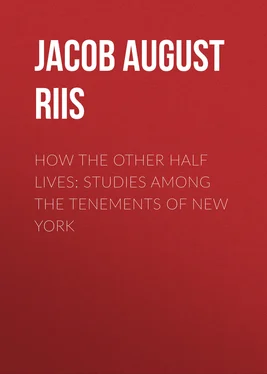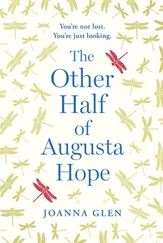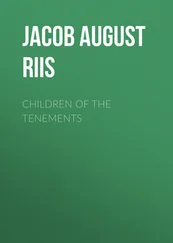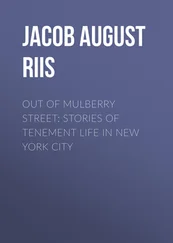Jacob August Riis - How the Other Half Lives - Studies Among the Tenements of New York
Здесь есть возможность читать онлайн «Jacob August Riis - How the Other Half Lives - Studies Among the Tenements of New York» — ознакомительный отрывок электронной книги совершенно бесплатно, а после прочтения отрывка купить полную версию. В некоторых случаях можно слушать аудио, скачать через торрент в формате fb2 и присутствует краткое содержание. Жанр: foreign_prose, sociology_book, foreign_antique, на английском языке. Описание произведения, (предисловие) а так же отзывы посетителей доступны на портале библиотеки ЛибКат.
- Название:How the Other Half Lives: Studies Among the Tenements of New York
- Автор:
- Жанр:
- Год:неизвестен
- ISBN:нет данных
- Рейтинг книги:3 / 5. Голосов: 1
-
Избранное:Добавить в избранное
- Отзывы:
-
Ваша оценка:
- 60
- 1
- 2
- 3
- 4
- 5
How the Other Half Lives: Studies Among the Tenements of New York: краткое содержание, описание и аннотация
Предлагаем к чтению аннотацию, описание, краткое содержание или предисловие (зависит от того, что написал сам автор книги «How the Other Half Lives: Studies Among the Tenements of New York»). Если вы не нашли необходимую информацию о книге — напишите в комментариях, мы постараемся отыскать её.
How the Other Half Lives: Studies Among the Tenements of New York — читать онлайн ознакомительный отрывок
Ниже представлен текст книги, разбитый по страницам. Система сохранения места последней прочитанной страницы, позволяет с удобством читать онлайн бесплатно книгу «How the Other Half Lives: Studies Among the Tenements of New York», без необходимости каждый раз заново искать на чём Вы остановились. Поставьте закладку, и сможете в любой момент перейти на страницу, на которой закончили чтение.
Интервал:
Закладка:
The determined effort to head it off by laying a strong hand upon the tenement builders that has been the chief business of the Health Board of recent years, dates from this period. The era of the air-shaft has not solved the problem of housing the poor, but it has made good use of limited opportunities. Over the new houses sanitary law exercises full control. But the old remain. They cannot be summarily torn down, though in extreme cases the authorities can order them cleared. The outrageous overcrowding, too, remains. It is characteristic of the tenements. Poverty, their badge and typical condition, invites—compels it. All efforts to abate it result only in temporary relief. As long as they exist it will exist with them. And the tenements will exist in New York forever.
To-day, what is a tenement? The law defines it as a house “occupied by three or more families, living independently and doing their cooking on the premises; or by more than two families on a floor, so living and cooking and having a common right in the halls, stairways, yards, etc.” That is the legal meaning, and includes flats and apartment-houses, with which we have nothing to do. In its narrower sense the typical tenement was thus described when last arraigned before the bar of public justice: “It is generally a brick building from four to six stories high on the street, frequently with a store on the first floor which, when used for the sale of liquor, has a side opening for the benefit of the inmates and to evade the Sunday law; four families occupy each floor, and a set of rooms consists of one or two dark closets, used as bedrooms, with a living room twelve feet by ten. The staircase is too often a dark well in the centre of the house, and no direct through ventilation is possible, each family being separated from the other by partitions. Frequently the rear of the lot is occupied by another building of three stories, high with two families on a floor.” The picture is nearly as true to-day as ten years ago, and will be for a long time to come. The dim light admitted by the air-shaft shines upon greater crowds than ever. Tenements are still “good property,” and the poverty of the poor man his destruction. A barrack down town where he has to live because he is poor brings in a third more rent than a decent flat house in Harlem. The statement once made a sensation that between seventy and eighty children had been found in one tenement. It no longer excites even passing attention, when the sanitary police report counting 101 adults and 91 children in a Crosby Street house, one of twins, built together. The children in the other, if I am not mistaken, numbered 89, a total of 180 for two tenements! Or when a midnight inspection in Mulberry Street unearths a hundred and fifty “lodgers” sleeping on filthy floors in two buildings. Spite of brown-stone trimmings, plate-glass and mosaic vestibule floors, the water does not rise in summer to the second story, while the beer flows unchecked to the all-night picnics on the roof. The saloon with the side-door and the landlord divide the prosperity of the place between them, and the tenant, in sullen submission, foots the bills.
Where are the tenements of to-day? Say rather: where are they not? In fifty years they have crept up from the Fourth Ward slums and the Five Points the whole length of the island, and have polluted the Annexed District to the Westchester line. Crowding all the lower wards, wherever business leaves a foot of ground unclaimed; strung along both rivers, like ball and chain tied to the foot of every street, and filling up Harlem with their restless, pent-up multitudes, they hold within their clutch the wealth and business of New York, hold them at their mercy in the day of mob-rule and wrath. The bullet-proof shutters, the stacks of hand-grenades, and the Gatling guns of the Sub-Treasury are tacit admissions of the fact and of the quality of the mercy expected. The tenements to-day are New York, harboring three-fourths of its population. When another generation shall have doubled the census of our city, and to that vast army of workers, held captive by poverty, the very name of home shall be as a bitter mockery, what will the harvest be?
CHAPTER III.
THE MIXED CROWD
When once I asked the agent of a notorious Fourth Ward alley how many people might be living in it I was told: One hundred and forty families, one hundred Irish, thirty-eight Italian, and two that spoke the German tongue. Barring the agent herself, there was not a native-born individual in the court. The answer was characteristic of the cosmopolitan character of lower New York, very nearly so of the whole of it, wherever it runs to alleys and courts. One may find for the asking an Italian, a German, a French, African, Spanish, Bohemian, Russian, Scandinavian, Jewish, and Chinese colony. Even the Arab, who peddles “holy earth” from the Battery as a direct importation from Jerusalem, has his exclusive preserves at the lower end of Washington Street. The one thing you shall vainly ask for in the chief city of America is a distinctively American community. There is none; certainly not among the tenements. Where have they gone to, the old inhabitants? I put the question to one who might fairly be presumed to be of the number, since I had found him sighing for the “good old days” when the legend “no Irish need apply” was familiar in the advertising columns of the newspapers. He looked at me with a puzzled air. “I don’t know,” he said. “I wish I did. Some went to California in ’49, some to the war and never came back. The rest, I expect, have gone to heaven, or somewhere. I don’t see them ’round here.”
Whatever the merit of the good man’s conjectures, his eyes did not deceive him. They are not here. In their place has come this queer conglomerate mass of heterogeneous elements, ever striving and working like whiskey and water in one glass, and with the like result: final union and a prevailing taint of whiskey. The once unwelcome Irishman has been followed in his turn by the Italian, the Russian Jew, and the Chinaman, and has himself taken a hand at opposition, quite as bitter and quite as ineffectual, against these later hordes. Wherever these have gone they have crowded him out, possessing the block, the street, the ward with their denser swarms. But the Irishman’s revenge is complete. Victorious in defeat over his recent as over his more ancient foe, the one who opposed his coming no less than the one who drove him out, he dictates to both their politics, and, secure in possession of the offices, returns the native his greeting with interest, while collecting the rents of the Italian whose house he has bought with the profits of his saloon. As a landlord he is picturesquely autocratic. An amusing instance of his methods came under my notice while writing these lines. An inspector of the Health Department found an Italian family paying a man with a Celtic name twenty-five dollars a month for three small rooms in a ramshackle rear tenement—more than twice what they were worth—and expressed his astonishment to the tenant, an ignorant Sicilian laborer. He replied that he had once asked the landlord to reduce the rent, but he would not do it.
“Well! What did he say?” asked the inspector.
“‘Damma, man!’ he said; ‘if you speaka thata way to me, I fira you and your things in the streeta.’” And the frightened Italian paid the rent.
In justice to the Irish landlord it must be said that like an apt pupil he was merely showing forth the result of the schooling he had received, re-enacting, in his own way, the scheme of the tenements. It is only his frankness that shocks. The Irishman does not naturally take kindly to tenement life, though with characteristic versatility he adapts himself to its conditions at once. It does violence, nevertheless, to the best that is in him, and for that very reason of all who come within its sphere soonest corrupts him. The result is a sediment, the product of more than a generation in the city’s slums, that, as distinguished from the larger body of his class, justly ranks at the foot of tenement dwellers, the so-called “low Irish.”
Читать дальшеИнтервал:
Закладка:
Похожие книги на «How the Other Half Lives: Studies Among the Tenements of New York»
Представляем Вашему вниманию похожие книги на «How the Other Half Lives: Studies Among the Tenements of New York» списком для выбора. Мы отобрали схожую по названию и смыслу литературу в надежде предоставить читателям больше вариантов отыскать новые, интересные, ещё непрочитанные произведения.
Обсуждение, отзывы о книге «How the Other Half Lives: Studies Among the Tenements of New York» и просто собственные мнения читателей. Оставьте ваши комментарии, напишите, что Вы думаете о произведении, его смысле или главных героях. Укажите что конкретно понравилось, а что нет, и почему Вы так считаете.












